OOP_EXPLAINED_example_of_cod_and_explainations.pdf
- 1. Program 1: Employee Class cpp Copy code #include <iostream> #include <string> using namespace std; class Employee { private: int empNo; string empName; float basic; float da; float it; float netSalary; public: void getData() { cout << "Enter Employee Number: "; cin >> empNo; cout << "Enter Employee Name: "; cin.ignore(); getline(cin, empName); cout << "Enter Basic Salary: "; cin >> basic; da = 0.52 * basic; it = 0.3 * (basic + da); netSalary = basic + da - it; } void displayData() { cout << "nEmployee Details:n"; cout << "Employee Number: " << empNo << endl; cout << "Employee Name: " << empName << endl; cout << "Basic Salary: " << basic << endl; cout << "DA: " << da << endl; cout << "Income Tax: " << it << endl; cout << "Net Salary: " << netSalary << endl; }
- 2. }; int main() { Employee emp; emp.getData(); emp.displayData(); return 0; } Explanation: 1. #include <iostream> and #include <string>: o Includes libraries for input/output operations (cin, cout) and string handling (string). 2. using namespace std;: o Avoids the need to prefix standard functions (e.g., std::cin). 3. class Employee: o Defines a class Employee with private and public members. o Private Members: ’é¦ empNo: Employee number. ’é¦ empName: Employee name. ’é¦ basic, da, it, netSalary: Basic salary, Dearness Allowance, Income Tax, and Net Salary, respectively. o Public Members: ’é¦ void getData(): ’é¦ Prompts the user to input employee details. ’é¦ Calculates: ’é¦ da as 52% of basic. ’é¦ it as 30% of the sum of basic and da. ’é¦ netSalary as basic + da - it. ’é¦ void displayData(): ’é¦ Displays the employee details, including computed values (da, it, netSalary). 4. int main(): o Creates an object emp of the Employee class. o Calls getData() to input details and displayData() to display the results. Program 2: Constructor Overloading cpp Copy code #include <iostream>
- 3. using namespace std; class Box { private: double length, width, height; public: Box() { length = width = height = 0; } Box(double l) { length = width = height = l; } Box(double l, double w, double h) { length = l; width = w; height = h; } double volume() { return length * width * height; } void display() { cout << "Volume: " << volume() << endl; } }; int main() { Box b1; Box b2(10); Box b3(10, 20, 30); cout << "Default Constructor: "; b1.display(); cout << "Single Parameter: "; b2.display();
- 4. cout << "Three Parameters: "; b3.display(); return 0; } Explanation: 1. #include <iostream> and using namespace std;: o Includes the library for input/output operations and uses the standard namespace. 2. class Box: o Defines a class to represent a 3D box with private data members (length, width, height) and public methods. o Constructors: ’é¦ Default Constructor: ’é¦ Initializes all dimensions (length, width, height) to zero. ’é¦ Single Parameter Constructor: ’é¦ Initializes all dimensions to the same value (l). ’é¦ Parameterized Constructor: ’é¦ Initializes dimensions to specified values (l, w, h). o Public Methods: ’é¦ double volume(): ’é¦ Returns the volume of the box (length * width * height). ’é¦ void display(): ’é¦ Prints the calculated volume of the box. 3. int main(): o Creates three objects of Box: ’é¦ b1 using the default constructor. ’é¦ b2 using the single-parameter constructor. ’é¦ b3 using the three-parameter constructor. o Calls the display() method for each object to show the volume. Program 3: Multilevel Inheritance cpp Copy code #include <iostream> using namespace std; class Animal {
- 5. protected: string species; public: void setSpecies(string s) { species = s; } }; class Mammal : public Animal { protected: int legs; public: void setLegs(int l) { legs = l; } }; class Dog : public Mammal { private: string breed; public: void setBreed(string b) { breed = b; } void display() { cout << "Species: " << species << endl; cout << "Legs: " << legs << endl; cout << "Breed: " << breed << endl; } }; int main() { Dog dog; dog.setSpecies("Canis"); dog.setLegs(4);
- 6. dog.setBreed("Labrador"); dog.display(); return 0; } Explanation: 1. #include <iostream> and using namespace std;: o Includes the library for input/output operations and uses the standard namespace. 2. Multilevel Inheritance: o class Animal: ’é¦ The base class with a protected member (species) and a public method to set its value (setSpecies). o class Mammal : public Animal: ’é¦ Inherits Animal and adds a protected member (legs) and a method to set its value (setLegs). o class Dog : public Mammal: ’é¦ Inherits Mammal and adds a private member (breed) and a method to set its value (setBreed). ’é¦ void display(): ’é¦ Displays the species, legs, and breed values. 3. int main(): o Creates an object dog of class Dog. o Calls setSpecies, setLegs, and setBreed to set values for species, number of legs, and breed. o Calls display() to print the details. Program 4: Array of Class Objects cpp Copy code #include <iostream> #include <string> using namespace std; class Student { private: string name; int rollNo; char grade; public: void getData() {
- 7. cout << "Enter Name: "; cin.ignore(); getline(cin, name); cout << "Enter Roll Number: "; cin >> rollNo; cout << "Enter Grade: "; cin >> grade; } void display() { cout << "nName: " << name; cout << "nRoll Number: " << rollNo; cout << "nGrade: " << grade << endl; } }; int main() { Student students[3]; for(int i = 0; i < 3; i++) { cout << "nEnter details for student " << i+1 << ":n"; students[i].getData(); } cout << "nStudent Details:n"; for(int i = 0; i < 3; i++) { students[i].display(); } return 0; } Explanation: 1. #include <iostream> and #include <string>: o Includes libraries for input/output operations and string handling. 2. class Student: o Represents a student with private data members (name, rollNo, grade) and public methods. o Public Methods:
- 8. ’é¦ void getData(): ’é¦ Prompts the user to input a students details and stores them in private members. ’é¦ void display(): ’é¦ Prints the stored student details. 3. int main(): o Creates an array students of size 3 to store details of three students. o Input Loop: ’é¦ Iterates over the array, calling getData() for each student. o Output Loop: ’é¦ Iterates over the array, calling display() for each student to print their details. Program 5: Function Overloading for Shapes cpp Copy code #include <iostream> using namespace std; class Shape { public: double perimeter(double radius) { return 2 * 3.14159 * radius; } double perimeter(double length, double width) { return 2 * (length + width); } double perimeter(double a, double b, double c) { return a + b + c; } }; int main() { Shape shape; cout << "Circle Perimeter: " << shape.perimeter(5) << endl; cout << "Rectangle Perimeter: " << shape.perimeter(4, 6) << endl;
- 9. cout << "Triangle Perimeter: " << shape.perimeter(3, 4, 5) << endl; return 0; } Explanation: 1. #include <iostream> and using namespace std;: o Includes the library for input/output operations and uses the standard namespace. 2. class Shape: o Represents a shape and contains three overloaded methods for calculating the perimeter of different shapes. o Method Overloading: ’é¦ perimeter(double radius): Calculates the perimeter of a circle (2 * ŽĆ * radius). ’é¦ perimeter(double length, double width): Calculates the perimeter of a rectangle (2 * (length + width)). ’é¦ perimeter(double a, double b, double c): Calculates the perimeter of a triangle (a + b + c). 3. int main(): o Creates an object shape of the Shape class. o Calls each of the overloaded perimeter() methods to calculate and display the perimeter of a circle, rectangle, and triangle. Program 6: Constructor with Default Arguments cpp Copy code #include <iostream> using namespace std; class Rectangle { private: double length; double width; public: Rectangle(double l = 1, double w = 1) { length = l; width = w; } void display() {
- 10. cout << "Length: " << length << ", Width: " << width << endl; cout << "Area: " << length * width << endl; } }; int main() { Rectangle r1; Rectangle r2(5); Rectangle r3(5, 10); cout << "Default values: "; r1.display(); cout << "One argument: "; r2.display(); cout << "Two arguments: "; r3.display(); return 0; } Explanation: 1. #include <iostream> and using namespace std;: o Includes the input/output library for cin and cout operations. 2. class Rectangle: o Represents a rectangle with private data members (length, width). o Constructor: ’é¦ The constructor accepts two arguments (l and w) with default values (1), meaning if no arguments are passed, both length and width will be initialized to 1. o void display(): ’é¦ Displays the dimensions (length, width) and the area (length * width) of the rectangle. 3. int main(): o Creates three objects of the Rectangle class: ’é¦ r1 uses the default constructor with no arguments. ’é¦ r2 uses the constructor with one argument (5 for both length and width). ’é¦ r3 uses the constructor with two arguments (5 and 10). o Calls display() for each object to show their details.
- 11. Program 7: Bank Account Class cpp Copy code #include <iostream> using namespace std; class Account { private: double balance; double interestRate; public: Account(double initial = 0, double rate = 0.05) { balance = initial; interestRate = rate; } void deposit(double amount) { if(amount > 0) { balance += amount; cout << "Deposited: " << amount << endl; } } void withdraw(double amount) { if(amount <= balance) { balance -= amount; cout << "Withdrawn: " << amount << endl; } else { cout << "Insufficient funds" << endl; } } void computeInterest() { double interest = balance * interestRate; balance += interest; cout << "Interest added: " << interest << endl; }
- 12. void showBalance() { cout << "Current balance: " << balance << endl; } }; int main() { Account acc(1000); acc.showBalance(); acc.deposit(500); acc.withdraw(200); acc.computeInterest(); acc.showBalance(); return 0; } Explanation: 1. #include <iostream> and using namespace std;: o Includes input/output functionality and the standard namespace. 2. class Account: o Represents a bank account with private members (balance and interestRate). o Constructor: ’é¦ Initializes balance with a default value of 0 and interestRate with 0.05 (5%). o Methods: ’é¦ void deposit(double amount): ’é¦ Deposits a positive amount into the account and displays the deposited amount. ’é¦ void withdraw(double amount): ’é¦ Withdraws an amount if sufficient balance is available. Displays an error message if insufficient funds. ’é¦ void computeInterest(): ’é¦ Computes and adds interest to the balance based on interestRate. ’é¦ void showBalance(): ’é¦ Displays the current balance. 3. int main(): o Creates an Account object acc with an initial balance of 1000. o Calls methods to deposit, withdraw, compute interest, and display the balance.
- 13. Program 8: Virtual Functions cpp Copy code #include <iostream> using namespace std; class Base { public: virtual void display() { cout << "Base class display" << endl; } virtual void show() { cout << "Base class show" << endl; } }; class Derived : public Base { public: void display() override { cout << "Derived class display" << endl; } void show() override { cout << "Derived class show" << endl; } }; int main() { Base* base; Derived derived; base = &derived; base->display(); base->show(); return 0; } Explanation:
- 14. 1. #include <iostream> and using namespace std;: o Includes the standard library for input/output operations. 2. class Base: o Defines a base class with two virtual methods: ’é¦ virtual void display(): ’é¦ A virtual method that can be overridden by derived classes. ’é¦ virtual void show(): ’é¦ Another virtual method. 3. class Derived : public Base: o Inherits from Base and overrides both virtual methods. o void display(): ’é¦ Overridden method in the derived class. o void show(): ’é¦ Overridden method in the derived class. 4. int main(): o Creates a pointer base of type Base and an object derived of type Derived. o base = &derived;: ’é¦ The base pointer points to the derived object, demonstrating polymorphism. o Calls base->display() and base->show(), which invoke the overridden methods in the Derived class due to virtual functions. 5. Polymorphism: o The use of virtual functions allows the derived class methods to be called through a base class pointer, ensuring dynamic dispatch. Program 9: Friend Function cpp Copy code #include <iostream> using namespace std; class Complex { private: double real; double imag; public: Complex(double r = 0, double i = 0) {
- 15. real = r; imag = i; } friend Complex addComplex(Complex c1, Complex c2); void display() { cout << real << " + " << imag << "i" << endl; } }; Complex addComplex(Complex c1, Complex c2) { Complex temp; temp.real = c1.real + c2.real; temp.imag = c1.imag + c2.imag; return temp; } int main() { Complex c1(3, 4), c2(5, 6); Complex sum = addComplex(c1, c2); cout << "First complex number: "; c1.display(); cout << "Second complex number: "; c2.display(); cout << "Sum: "; sum.display(); return 0; } Explanation: 1. #include <iostream> and using namespace std;: o Includes the necessary libraries for input/output operations. 2. class Complex: o Represents a complex number with private members real and imag. o Constructor: ’é¦ Initializes the complex number with default values (0 for both real and imag).
- 16. o Friend Function: ’é¦ friend Complex addComplex(Complex c1, Complex c2): ’é¦ This function is declared as a friend of the Complex class, allowing it to access private members (real and imag) directly. ’é¦ void display(): ’é¦ Displays the complex number in the form real + imag i. 3. Complex addComplex(Complex c1, Complex c2): o Adds two complex numbers by adding their real and imaginary parts separately. 4. int main(): o Creates two complex numbers c1 and c2. o Uses the addComplex function to compute their sum and displays the results. Program 10: File Handling cpp Copy code #include <iostream> #include <fstream> #include <string> using namespace std; int main() { ofstream outFile("sample.txt"); if(outFile.is_open()) { outFile << "This is a line written to the file.n"; outFile << "This is another line.n"; outFile << "Adding some numbers: " << 42 << endl; outFile.close(); cout << "File created and content written successfully." << endl; } else { cout << "Unable to open file." << endl; } ifstream inFile("sample.txt"); string line;
- 17. cout << "nReading file contents:n"; if(inFile.is_open()) { while(getline(inFile, line)) { cout << line << endl; } inFile.close(); } return 0; } Explanation: 1. #include <iostream>, #include <fstream>, and #include <string>: o Includes the libraries for input/output operations, file handling (fstream), and string manipulation. 2. ofstream outFile("sample.txt");: o Creates an ofstream object to write data to a file named sample.txt. o if(outFile.is_open()): ’é¦ Checks if the file is successfully opened. If true, writes lines to the file and closes it. 3. ifstream inFile("sample.txt");: o Creates an ifstream object to read data from the file sample.txt. o while(getline(inFile, line)): ’é¦ Reads the file line by line and prints each line. 4. File Operations: o If the file cannot be opened, an error message is printed. o After reading, the file is closed.
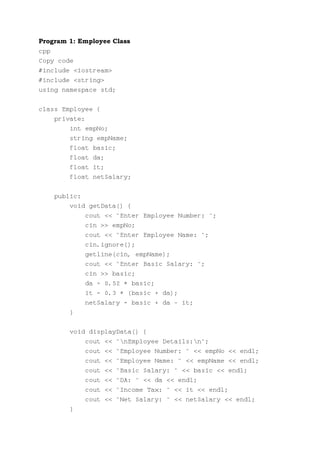

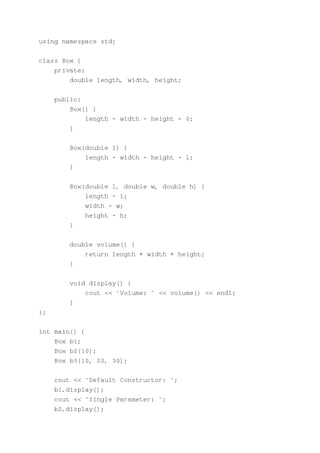
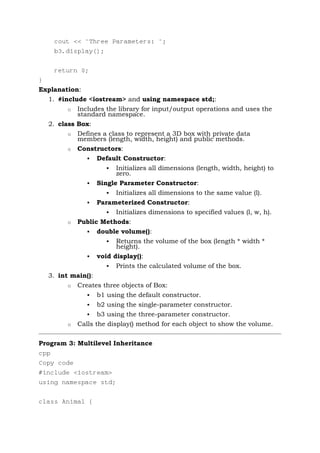
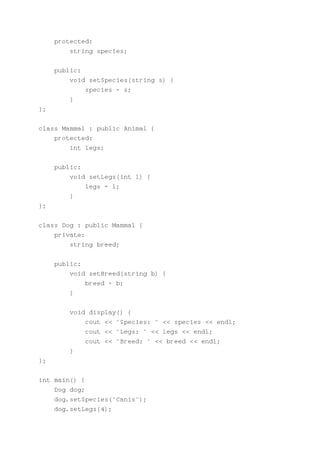
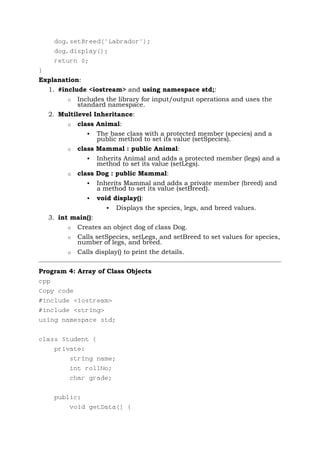
![cout << "Enter Name: ";
cin.ignore();
getline(cin, name);
cout << "Enter Roll Number: ";
cin >> rollNo;
cout << "Enter Grade: ";
cin >> grade;
}
void display() {
cout << "nName: " << name;
cout << "nRoll Number: " << rollNo;
cout << "nGrade: " << grade << endl;
}
};
int main() {
Student students[3];
for(int i = 0; i < 3; i++) {
cout << "nEnter details for student " << i+1 <<
":n";
students[i].getData();
}
cout << "nStudent Details:n";
for(int i = 0; i < 3; i++) {
students[i].display();
}
return 0;
}
Explanation:
1. #include <iostream> and #include <string>:
o Includes libraries for input/output operations and string
handling.
2. class Student:
o Represents a student with private data members (name, rollNo,
grade) and public methods.
o Public Methods:](https://image.slidesharecdn.com/oopexplained-250309082150-3e3195eb/85/OOP_EXPLAINED_example_of_cod_and_explainations-pdf-7-320.jpg)
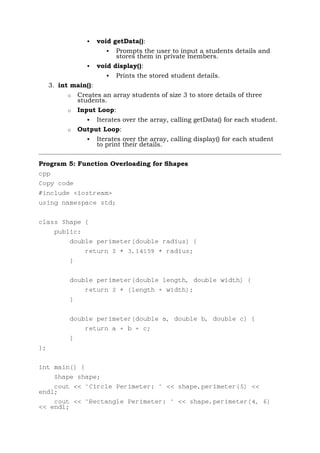
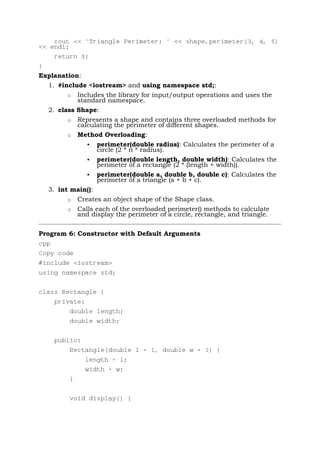
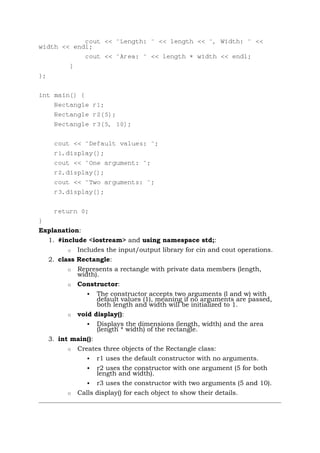
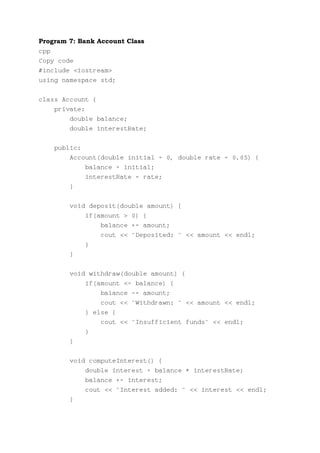
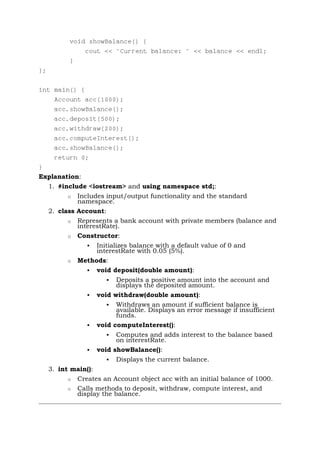
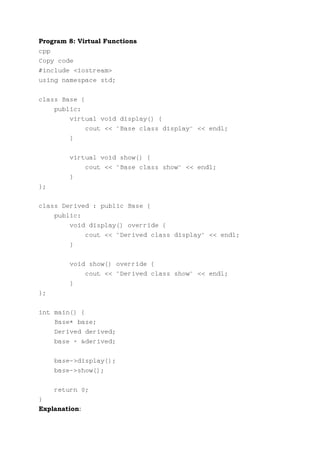
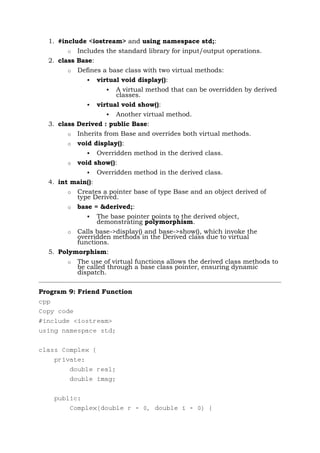
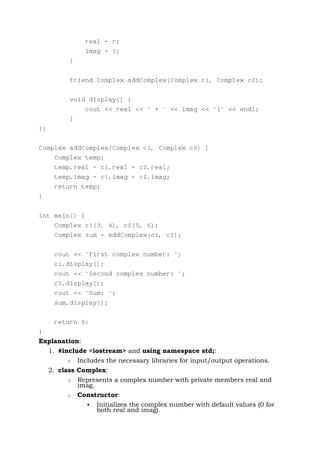
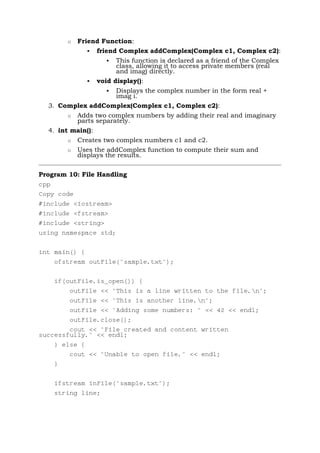
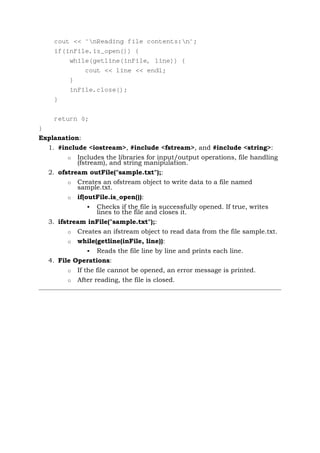






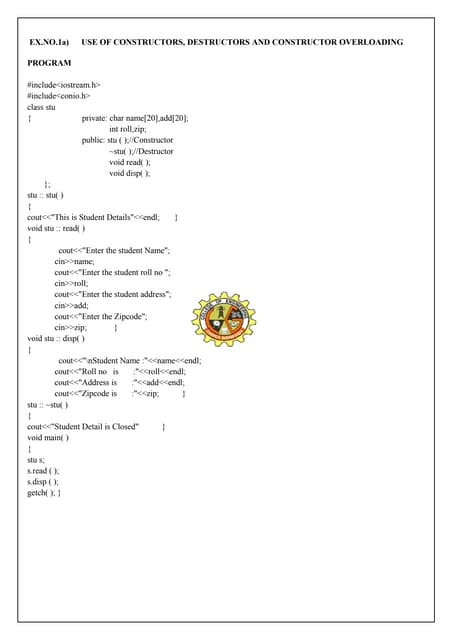































![Movavi Video Editor Crack + Activation Key [2025]](https://cdn.slidesharecdn.com/ss_thumbnails/simunsunjiclovromatosevic-250216112916-e19beeba-250404023804-5918a24a-250407081855-ec0bae8c-thumbnail.jpg?width=560&fit=bounds)


![Parallels Desktop Crack [Latest] 2025 free](https://cdn.slidesharecdn.com/ss_thumbnails/worlddayofbullyingpreventionactivitiesinfographicsbyslidesgo-250228090445-a5019b4d-250403064534-1338-250406211207-5ba8239d-thumbnail.jpg?width=560&fit=bounds)





